|
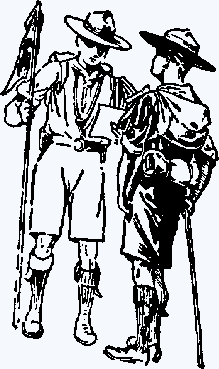
Camp Fire Yarn No. 4
SCOUT PATROLS
Patrol System • Patrol Leader Patrol Signs • Games
Each scout troop consists of two or more Patrols of six to eight boys. The main object of the Patrol
System is to give real responsibility to as many boys as possible. It leads each boy to see that he has some individual responsibility
for the good of his Patrol. It leads each Patrol to see that it has definite responsibility for the good of the Troop. Through
the Patrol System the Scouts learn that they have considerable say in what their Troop does.
THE PATROL LEADER
Each Patrol has a boy as leader. He is called the Patrol Leader. The Scoutmaster expects a great deal
from the Patrol Leader and leaves him a free hand in carrying out the work in the Patrol. The Patrol Leader selects another
boy to be second in command. This boy is called a Second. The Patrol Leader is responsible for the efficiency and smartness
of his Patrol. The Scouts in his Patrol obey his Orders, not from fear of punishment, as is often the case in military discipline,
but because they are a team playing together and backing up their leader for the honour and success of the Patrol.
And the Patrol Leader, in training and leading his Patrol, is gaining practice and experience for being
a fellow who can take responsibility.
Also, besides training his Patrol, the Patrol Leader has to lead it, that is, he must be at
least as good as any of his Scouts at the different Jobs they have to do. He must never ask a fellow to do anything he would
not do himself. And he must never be "down" on anyone but must get the enthusiasm and willing work of everyone by cheerily
encouraging their efforts.
In every line of life young men are wanted who can be trusted to take responsibility and leadership.
So the Patrol Leader who has made a success with his Patrol has every chance of making a success of his life when he goes
out into the world.
Most of your work in the Patrol consists in playing Scouting games and practices by which you gain
experience as Scouts.
THE COURT OF HONOUR
The Court of Honour is an important part of the Patrol System. It is a Standing committee which settles
the affairs of the Troop. A Court of Honour is formed of the Patrol Leaders, or, in the case of a small Troop, of the Patrol
Leaders and Seconds. The Scoutmaster attends the meetings as an adviser but does not vote. Patrol Leaders in a Court of Honour
have in many cases carried on the Troop in the absence of the Scoutmaster.
The Court of Honour decides programmes of work, camps, rewards and other questions affecting Troop
management. The members of the Court are pledged to secrecy. Only those decisions which affect the whole Troop, that is, competitions,
appointments, " and so on, would be made public.
A WORD TO PATROL LEADERS
I want you Patrol Leaders to go on and train your Patrols entirely yourselves, because it is possible
for you to get hold of each boy in your Patrol and make a good fellow of him. It is no use having one or two brilliant boys
and the rest no good at all. You should try to make them all fairly good.
The most important step to this is your own example, because what you do yourselves, your Scouts will
do also.
Show them that you can obey Orders whether they are given by word of mouth or are printed or-written
rules, and that you carry them out whether your Scoutmaster is present or not. Show them that you can earn Proficiency Badges,
and your boys will follow with very little persuasion. But remember that you must give them the not the push.
PATROL NAMES AND SIGNS
Each Troop is named after the place to which it belongs. Each Patrol in the Troop is named after an
animal or bird. It is a good plan to choose only animals and birds found in your district. Thus the 33rd London Troop may
have five Patrols which are respectively the Wolves, the Ravens, the Curlews, the Bulls, the Owls.
Each Patrol Leader has a small flag on his staff with his Patrol animal shown on it on both sides.
Each Scout in a Patrol has his regular number. The Patrol Leader
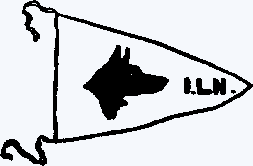
is No. 1, the Second No. 2. The other Scouts have the consecutive numbers after these. Scouts usually
work in pairs as comrades, Nos. 3 and 4 together, Nos. 5 and 6 together, and Nos. 7 and 8.
Here are The signs and calls of the Patrols we used at the first Scout camp at Brownsea, of course
there are many more you can choose from.
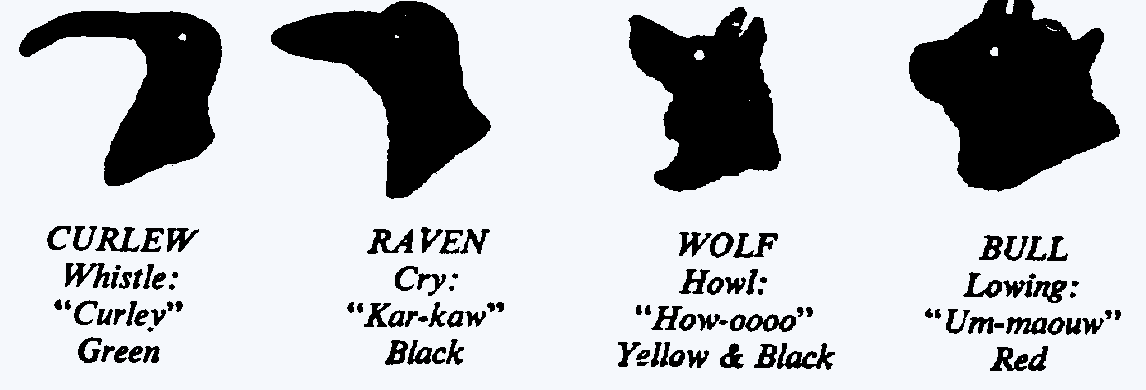
PATROL GALL
Each Scout in the Patrol has to be able to make the call of his Patrol animal-thus every Scout in the
"Bulldogs" must be able to
Imitate the growl of the bulldog. This is the signal by which Scouts of a Patrol can communicate with
each other when hiding or al night. No Scout is allowed to use the call of any Patrol except his own. The Patrol Leader calls
his Patrol at any time by sounding his whistle and giving the Patrol call.
WOODCRAFT TRAIL SIGNS
Scout trail signs are made on the ground, close to the right-hand side of the road. They should never
be made where they will damage or disfigure private property.
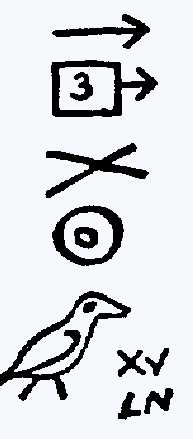
Road to be followed.
Letter hidden three paces from here in the direction of the arrow.
This
path not to be followed.
"I have gone home."
(Signed) "Patrol Leader of the Ravens, Fifteenth London Troop."

"This is the way"

"Turn to the right"
When a Scout makes signs on the ground for others to read he also draws the head of the Patrol animal.
Thus if he wants to show that a certain road should not be followed he draws a sign across it that means "Not to be followed",
and adds the head of his Patrol animal to show which Patrol discovered that the road was no good, and his own number to show
which Scout discovered it, thus:
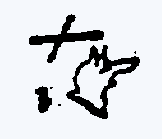
At night sticks with a wisp of grass round them or stones should be laid on the road in similar forms
so that they can be felt with the band.
PATROL PRACTICES
Each Scout should learn the call of his Patrol animal. He should be encouraged to know all he can about
its habits, etc. This can be a first step in nature lore.
Each Scout should know how to make a simple drawing of his Patrol animal. The Scouts should use this
as their Patrol signature.
The special Scout signs should be used out-of-doors. They can be made in the dust, or by using sticks,
and so on. A good tracking game can be arranged by using signs only.
Acting in all forms should be encouraged: mock trials and impromptu plays are excellent training and
useful for evenings around the camp fire or when you have to be indoors.
GAMES
Scout Meets Scout
Single Scouts, or pairs of Scouts or complete Patrols, are taken out about two miles apart. They are
then made to move towards each other, either alongside a road, or by giving each side a landmark to move towards, such as
a steep hill or big tree, which is directly behind the other party and will thus ensure their coming together. The Patrol
which first sees the other wins. This is signified by the Patrol Leader holding up his Patrol nag for the umpire to see, and
sounding his whistle. A Patrol need not keep together, but that Patrol wins which first holds up its flag; so it is well for
the Scouts to keep in touch with their Patrol Leaders by signal, voice, or message.
Scouts may employ any ruse they like, such as climbing into trees, hiding in carts, etc., but they
must not dress up in disguise unless specially permitted.
This game may also be practised at night.
Debates
A good exercise for a winter's evening in the meeting room is to hold a debate on any subject of topical
interest, with the Scoutmaster acting as chairman. He will see that there is a Speaker prepared beforehand to introduce and
support one view of the subject, and another Speaker prepared to expound another view. After hearing them, he will call on
the others present in turn to express their views. In the end he takes the votes for and against the motion.
At first boys will be very shy of speaking unless the subject selected by the Scoutmaster is one which
really interests them and takes | them out of themselves.
After a debate or two they get greater confidence, and are able to express themselves coherently. They
also pick up the proper procedure for public meetings, such as seconding a motion, moving amendments, obeying the chairman's
ruling, voting, according votes of thanks to the chair, etc.
Mock Trial
In place of a debate a mock trial may be of interest as a change.
For instance, the story of the Eisdon Murder given in Yarn No. 2 might form the subject of a trial.
The Scoutmaster acts as judge, and details boys to the following parts:
Prisoner ... William Winter.
Witness ...Boy, Robert Hindmarsh.
"
...Police Constable.
" ...Villager.
" ...Old woman (friend of the murdered woman).
Counsel for Prisoner.
"
...Prosecution.
Foreman and Jury (if there are enough Scouts).
Follow as nearly as possible the procedure of a court of law. Let each make up his own evidence, speeches,
or cross-examination according to his own notions and imagination, along the lines of the story, but in greater detail. Do
not necessarily and the prisoner guilty unless the prosecution proves its case to the Jury.
In summing up, the Scoutmaster may bring out the fact that the boy, Hindmarsh, carried out each part
of the duty of a Scout, in order to bring home the lesson, to the boys.
Unprepared Plays
The plot of a short, simple play is given, and each player is assigned his part, with an outline of
what he has to do and say. The Scouts act it, making up the required conversation as they go along.
This develops the power of imagination and expression.

Scout Songs
The Scout's Chorus. This is a chant t hat the African Zulus used to sing to their Chief. It may be
shouted on the march, or used as applause at games and meetings and camp fires. It must be sung exactly in time.


Leader: Eengonyama-gonyama.
Chorus: Invooboo. Ya-Boh! Ya-Boh! Invooboo!
The meaning
is-
Leader: "He is a lion!"
Chorus: "Yes! he is better than that; he is a hippopotamus!"
The Scout's Rally.To be shouted as a salute, or in a game, or at any other appropriate time.
Leader: Be Prepared!
Chorus: Zing-a-Zing! Bom! Bom!
(Stamp or bang something at the "Bom! Bom!")
The Scout's Call. For a Scout to whistle to attract
the attention of another Scout.
Scouts' Dance
Scouts form up in one line with the leader in front, each holding his staff in the right band, and
his left on the next man's shoulder.
Leader sings the Eengonyama song. Scouts sing chorus, and advance a few steps at a time, stamping in
unison on the long notes.
At the second time of singing they step backwards.
At the third, they turn to the left, still holding each other's shoulders, and move round in a large
circle, repeating the chorus until they have completed the circle.
They then form into a wide circle, into the centre of which one Steps forward and carries out a war
dance, representing how he tracked and fought with one of his enemies. He goes through the whole fight in dumb show, until
he finally kills his foe. The Scouts meantime sing the Eengonyama chorus and dance on their own ground. As soon as he finishes
the fight, the leader Starts the "Be Prepared" chorus, which they repeat three times in honour of the Scout who has just danced.
Then they recommence the Eengonyama chorus, and another Scout Steps into the ring, and describes in
dumb show how he stalked and killed a wild buffalo. While he does the creeping up and stalking of the animal, the Scouts all
crouch and sing their chorus very softly, and as he gets close to the beast, they simultaneously spring up and dance and shout
the chorus loudly. When he has slain the beast, the leader again gives the "Be Prepared" chorus in his honour, which is repeated
three times, the Scouts banging their staffs on the ground at the same time as they stamp
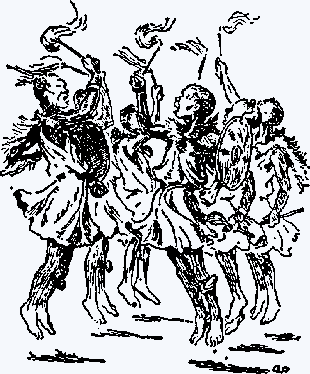
"Bom! Bom!" At the end of the third repetition, "Bom! Bom!" is given twice.
The circle then closes together, the Scouts turn to their left again, grasping shoulders with the left
band, and move off, singing the Eengonyama chorus, or, if it is not desired to move away, they break up after the final "Bom!
Bom!"
The Eengonyama song should be sung in a spirited way, and not droned out dismally like a dirge.
FOR WINTER IN NORTHERN COUNTRJES
Arctic Expedition
Each Patrol makes a bobsleigh with ropes and harness, for two of their number to pull (or for dogs
if they have them, and can train them to the work). Two Scouts go a mile or so ahead; the remainder with the sleigh follow,
finding the way by means of the spoor, and f by such signs as the leading Scout may draw in the snow. All other signs seen
on the way are to be examined, noted, and their meaning read. The sleigh carries rations and cooking pots, and other supplies.
Build snow huts. These must be made narrow, according to the length of branches available for forming
the roof, which can be made with brushwood, and covered with snow.
Snow Fort
The snow fort may be built by one Patrol according to the boys' own ideas of fortification, with loopholes
for looking out. When finished it will be attacked by hostile Patrols, using snowballs as ammunition. Every Scout struck by
a snow ball is counted dead. The attackers should, as a rule, number at least twice the strength of the defenders.
Siberian Man Hunt
One Scout as fugitive runs away across the snow in any direction he may please until he finds a good
hiding-place, and there conceals himself. The remainder, after giving him twenty minutes' Start or more, proceed to follow
him by his tracks. As they approach his hiding-place, he shoots at them with snowballs, and everyone who is struck must fall
out dead. The fugitive must be struck three times before he is counted dead.
In Towns
Scouts can be very useful in snowy weather by working as a Patrol under their leader in Clearing away
the snow from pavements, houses, etc. And in fog by acting as guides. This they may either do as a Good Turn, or accept money
to be devoted to their funds. |
Scouting for Boys

Camp Fire Yarn No. 4
SCOUT PATROLS
Patrol System • Patrol Leader Patrol Signs • Games
Each scout troop consists of two or more Patrols of six to eight boys. The main object of the Patrol
System is to give real responsibility to as many boys as possible. It leads each boy to see that he has some individual responsibility
for the good of his Patrol. It leads each Patrol to see that it has definite responsibility for the good of the Troop. Through
the Patrol System the Scouts learn that they have considerable say in what their Troop does.
THE PATROL LEADER
Each Patrol has a boy as leader. He is called the Patrol Leader. The Scoutmaster expects a great deal
from the Patrol Leader and leaves him a free hand in carrying out the work in the Patrol. The Patrol Leader selects another
boy to be second in command. This boy is called a Second. The Patrol Leader is responsible for the efficiency and smartness
of his Patrol. The Scouts in his Patrol obey his Orders, not from fear of punishment, as is often the case in military discipline,
but because they are a team playing together and backing up their leader for the honour and success of the Patrol.
And the Patrol Leader, in training and leading his Patrol, is gaining practice and experience for being
a fellow who can take responsibility.
Also, besides training his Patrol, the Patrol Leader has to lead it, that is, he must be at
least as good as any of his Scouts at the different Jobs they have to do. He must never ask a fellow to do anything he would
not do himself. And he must never be "down" on anyone but must get the enthusiasm and willing work of everyone by cheerily
encouraging their efforts.
In every line of life young men are wanted who can be trusted to take responsibility and leadership.
So the Patrol Leader who has made a success with his Patrol has every chance of making a success of his life when he goes
out into the world.
Most of your work in the Patrol consists in playing Scouting games and practices by which you gain
experience as Scouts.
THE COURT OF HONOUR
The Court of Honour is an important part of the Patrol System. It is a Standing committee which settles
the affairs of the Troop. A Court of Honour is formed of the Patrol Leaders, or, in the case of a small Troop, of the Patrol
Leaders and Seconds. The Scoutmaster attends the meetings as an adviser but does not vote. Patrol Leaders in a Court of Honour
have in many cases carried on the Troop in the absence of the Scoutmaster.
The Court of Honour decides programmes of work, camps, rewards and other questions affecting Troop
management. The members of the Court are pledged to secrecy. Only those decisions which affect the whole Troop, that is, competitions,
appointments, " and so on, would be made public.
A WORD TO PATROL LEADERS
I want you Patrol Leaders to go on and train your Patrols entirely yourselves, because it is possible
for you to get hold of each boy in your Patrol and make a good fellow of him. It is no use having one or two brilliant boys
and the rest no good at all. You should try to make them all fairly good.
The most important step to this is your own example, because what you do yourselves, your Scouts will
do also.
Show them that you can obey Orders whether they are given by word of mouth or are printed or-written
rules, and that you carry them out whether your Scoutmaster is present or not. Show them that you can earn Proficiency Badges,
and your boys will follow with very little persuasion. But remember that you must give them the not the push.
PATROL NAMES AND SIGNS
Each Troop is named after the place to which it belongs. Each Patrol in the Troop is named after an
animal or bird. It is a good plan to choose only animals and birds found in your district. Thus the 33rd London Troop may
have five Patrols which are respectively the Wolves, the Ravens, the Curlews, the Bulls, the Owls.
Each Patrol Leader has a small flag on his staff with his Patrol animal shown on it on both sides.
Each Scout in a Patrol has his regular number. The Patrol Leader

is No. 1, the Second No. 2. The other Scouts have the consecutive numbers after these. Scouts usually
work in pairs as comrades, Nos. 3 and 4 together, Nos. 5 and 6 together, and Nos. 7 and 8.
Here are The signs and calls of the Patrols we used at the first Scout camp at Brownsea, of course
there are many more you can choose from.

PATROL GALL
Each Scout in the Patrol has to be able to make the call of his Patrol animal-thus every Scout in the
"Bulldogs" must be able to
Imitate the growl of the bulldog. This is the signal by which Scouts of a Patrol can communicate with
each other when hiding or al night. No Scout is allowed to use the call of any Patrol except his own. The Patrol Leader calls
his Patrol at any time by sounding his whistle and giving the Patrol call.
WOODCRAFT TRAIL SIGNS
Scout trail signs are made on the ground, close to the right-hand side of the road. They should never
be made where they will damage or disfigure private property.

Road to be followed.
Letter hidden three paces from here in the direction of the arrow.
This
path not to be followed.
"I have gone home."
(Signed) "Patrol Leader of the Ravens, Fifteenth London Troop."

"This is the way"

"Turn to the right"
When a Scout makes signs on the ground for others to read he also draws the head of the Patrol animal.
Thus if he wants to show that a certain road should not be followed he draws a sign across it that means "Not to be followed",
and adds the head of his Patrol animal to show which Patrol discovered that the road was no good, and his own number to show
which Scout discovered it, thus:

At night sticks with a wisp of grass round them or stones should be laid on the road in similar forms
so that they can be felt with the band.
PATROL PRACTICES
Each Scout should learn the call of his Patrol animal. He should be encouraged to know all he can about
its habits, etc. This can be a first step in nature lore.
Each Scout should know how to make a simple drawing of his Patrol animal. The Scouts should use this
as their Patrol signature.
The special Scout signs should be used out-of-doors. They can be made in the dust, or by using sticks,
and so on. A good tracking game can be arranged by using signs only.
Acting in all forms should be encouraged: mock trials and impromptu plays are excellent training and
useful for evenings around the camp fire or when you have to be indoors.
GAMES
Scout Meets Scout
Single Scouts, or pairs of Scouts or complete Patrols, are taken out about two miles apart. They are
then made to move towards each other, either alongside a road, or by giving each side a landmark to move towards, such as
a steep hill or big tree, which is directly behind the other party and will thus ensure their coming together. The Patrol
which first sees the other wins. This is signified by the Patrol Leader holding up his Patrol nag for the umpire to see, and
sounding his whistle. A Patrol need not keep together, but that Patrol wins which first holds up its flag; so it is well for
the Scouts to keep in touch with their Patrol Leaders by signal, voice, or message.
Scouts may employ any ruse they like, such as climbing into trees, hiding in carts, etc., but they
must not dress up in disguise unless specially permitted.
This game may also be practised at night.
Debates
A good exercise for a winter's evening in the meeting room is to hold a debate on any subject of topical
interest, with the Scoutmaster acting as chairman. He will see that there is a Speaker prepared beforehand to introduce and
support one view of the subject, and another Speaker prepared to expound another view. After hearing them, he will call on
the others present in turn to express their views. In the end he takes the votes for and against the motion.
At first boys will be very shy of speaking unless the subject selected by the Scoutmaster is one which
really interests them and takes | them out of themselves.
After a debate or two they get greater confidence, and are able to express themselves coherently. They
also pick up the proper procedure for public meetings, such as seconding a motion, moving amendments, obeying the chairman's
ruling, voting, according votes of thanks to the chair, etc.
Mock Trial
In place of a debate a mock trial may be of interest as a change.
For instance, the story of the Eisdon Murder given in Yarn No. 2 might form the subject of a trial.
The Scoutmaster acts as judge, and details boys to the following parts:
Prisoner ... William Winter.
Witness ...Boy, Robert Hindmarsh.
"
...Police Constable.
" ...Villager.
" ...Old woman (friend of the murdered woman).
Counsel for Prisoner.
"
...Prosecution.
Foreman and Jury (if there are enough Scouts).
Follow as nearly as possible the procedure of a court of law. Let each make up his own evidence, speeches,
or cross-examination according to his own notions and imagination, along the lines of the story, but in greater detail. Do
not necessarily and the prisoner guilty unless the prosecution proves its case to the Jury.
In summing up, the Scoutmaster may bring out the fact that the boy, Hindmarsh, carried out each part
of the duty of a Scout, in order to bring home the lesson, to the boys.
Unprepared Plays
The plot of a short, simple play is given, and each player is assigned his part, with an outline of
what he has to do and say. The Scouts act it, making up the required conversation as they go along.
This develops the power of imagination and expression.

Scout Songs
The Scout's Chorus. This is a chant t hat the African Zulus used to sing to their Chief. It may be
shouted on the march, or used as applause at games and meetings and camp fires. It must be sung exactly in time.


Leader: Eengonyama-gonyama.
Chorus: Invooboo. Ya-Boh! Ya-Boh! Invooboo!
The meaning
is-
Leader: "He is a lion!"
Chorus: "Yes! he is better than that; he is a hippopotamus!"
The Scout's Rally.To be shouted as a salute, or in a game, or at any other appropriate time.
Leader: Be Prepared!
Chorus: Zing-a-Zing! Bom! Bom!
(Stamp or bang something at the "Bom! Bom!")
The Scout's Call. For a Scout to whistle to attract
the attention of another Scout.
Scouts' Dance
Scouts form up in one line with the leader in front, each holding his staff in the right band, and
his left on the next man's shoulder.
Leader sings the Eengonyama song. Scouts sing chorus, and advance a few steps at a time, stamping in
unison on the long notes.
At the second time of singing they step backwards.
At the third, they turn to the left, still holding each other's shoulders, and move round in a large
circle, repeating the chorus until they have completed the circle.
They then form into a wide circle, into the centre of which one Steps forward and carries out a war
dance, representing how he tracked and fought with one of his enemies. He goes through the whole fight in dumb show, until
he finally kills his foe. The Scouts meantime sing the Eengonyama chorus and dance on their own ground. As soon as he finishes
the fight, the leader Starts the "Be Prepared" chorus, which they repeat three times in honour of the Scout who has just danced.
Then they recommence the Eengonyama chorus, and another Scout Steps into the ring, and describes in
dumb show how he stalked and killed a wild buffalo. While he does the creeping up and stalking of the animal, the Scouts all
crouch and sing their chorus very softly, and as he gets close to the beast, they simultaneously spring up and dance and shout
the chorus loudly. When he has slain the beast, the leader again gives the "Be Prepared" chorus in his honour, which is repeated
three times, the Scouts banging their staffs on the ground at the same time as they stamp

"Bom! Bom!" At the end of the third repetition, "Bom! Bom!" is given twice.
The circle then closes together, the Scouts turn to their left again, grasping shoulders with the left
band, and move off, singing the Eengonyama chorus, or, if it is not desired to move away, they break up after the final "Bom!
Bom!"
The Eengonyama song should be sung in a spirited way, and not droned out dismally like a dirge.
FOR WINTER IN NORTHERN COUNTRJES
Arctic Expedition
Each Patrol makes a bobsleigh with ropes and harness, for two of their number to pull (or for dogs
if they have them, and can train them to the work). Two Scouts go a mile or so ahead; the remainder with the sleigh follow,
finding the way by means of the spoor, and f by such signs as the leading Scout may draw in the snow. All other signs seen
on the way are to be examined, noted, and their meaning read. The sleigh carries rations and cooking pots, and other supplies.
Build snow huts. These must be made narrow, according to the length of branches available for forming
the roof, which can be made with brushwood, and covered with snow.
Snow Fort
The snow fort may be built by one Patrol according to the boys' own ideas of fortification, with loopholes
for looking out. When finished it will be attacked by hostile Patrols, using snowballs as ammunition. Every Scout struck by
a snow ball is counted dead. The attackers should, as a rule, number at least twice the strength of the defenders.
Siberian Man Hunt
One Scout as fugitive runs away across the snow in any direction he may please until he finds a good
hiding-place, and there conceals himself. The remainder, after giving him twenty minutes' Start or more, proceed to follow
him by his tracks. As they approach his hiding-place, he shoots at them with snowballs, and everyone who is struck must fall
out dead. The fugitive must be struck three times before he is counted dead.
In Towns
Scouts can be very useful in snowy weather by working as a Patrol under their leader in Clearing away
the snow from pavements, houses, etc. And in fog by acting as guides. This they may either do as a Good Turn, or accept money
to be devoted to their funds. |
|

